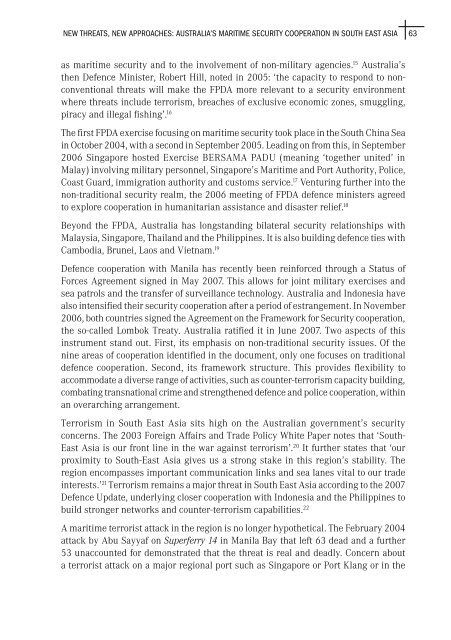Australian Maritime Issues 2007 - Royal Australian Navy
Australian Maritime Issues 2007 - Royal Australian Navy
Australian Maritime Issues 2007 - Royal Australian Navy
Create successful ePaper yourself
Turn your PDF publications into a flip-book with our unique Google optimized e-Paper software.
New Threats, New Approaches: Australia’s <strong>Maritime</strong> Security Cooperation in South East Asia<br />
63<br />
as maritime security and to the involvement of non-military agencies. 15 Australia’s<br />
then Defence Minister, Robert Hill, noted in 2005: ‘the capacity to respond to nonconventional<br />
threats will make the FPDA more relevant to a security environment<br />
where threats include terrorism, breaches of exclusive economic zones, smuggling,<br />
piracy and illegal fishing’. 16<br />
The first FPDA exercise focusing on maritime security took place in the South China Sea<br />
in October 2004, with a second in September 2005. Leading on from this, in September<br />
2006 Singapore hosted Exercise BERSAMA PADU (meaning ‘together united’ in<br />
Malay) involving military personnel, Singapore’s <strong>Maritime</strong> and Port Authority, Police,<br />
Coast Guard, immigration authority and customs service. 17 Venturing further into the<br />
non-traditional security realm, the 2006 meeting of FPDA defence ministers agreed<br />
to explore cooperation in humanitarian assistance and disaster relief. 18<br />
Beyond the FPDA, Australia has longstanding bilateral security relationships with<br />
Malaysia, Singapore, Thailand and the Philippines. It is also building defence ties with<br />
Cambodia, Brunei, Laos and Vietnam. 19<br />
Defence cooperation with Manila has recently been reinforced through a Status of<br />
Forces Agreement signed in May <strong>2007</strong>. This allows for joint military exercises and<br />
sea patrols and the transfer of surveillance technology. Australia and Indonesia have<br />
also intensified their security cooperation after a period of estrangement. In November<br />
2006, both countries signed the Agreement on the Framework for Security cooperation,<br />
the so-called Lombok Treaty. Australia ratified it in June <strong>2007</strong>. Two aspects of this<br />
instrument stand out. First, its emphasis on non-traditional security issues. Of the<br />
nine areas of cooperation identified in the document, only one focuses on traditional<br />
defence cooperation. Second, its framework structure. This provides flexibility to<br />
accommodate a diverse range of activities, such as counter-terrorism capacity building,<br />
combating transnational crime and strengthened defence and police cooperation, within<br />
an overarching arrangement.<br />
Terrorism in South East Asia sits high on the <strong>Australian</strong> government’s security<br />
concerns. The 2003 Foreign Affairs and Trade Policy White Paper notes that ‘South-<br />
East Asia is our front line in the war against terrorism’. 20 It further states that ‘our<br />
proximity to South-East Asia gives us a strong stake in this region’s stability. The<br />
region encompasses important communication links and sea lanes vital to our trade<br />
interests.’ 21 Terrorism remains a major threat in South East Asia according to the <strong>2007</strong><br />
Defence Update, underlying closer cooperation with Indonesia and the Philippines to<br />
build stronger networks and counter-terrorism capabilities. 22<br />
A maritime terrorist attack in the region is no longer hypothetical. The February 2004<br />
attack by Abu Sayyaf on Superferry 14 in Manila Bay that left 63 dead and a further<br />
53 unaccounted for demonstrated that the threat is real and deadly. Concern about<br />
a terrorist attack on a major regional port such as Singapore or Port Klang or in the
















